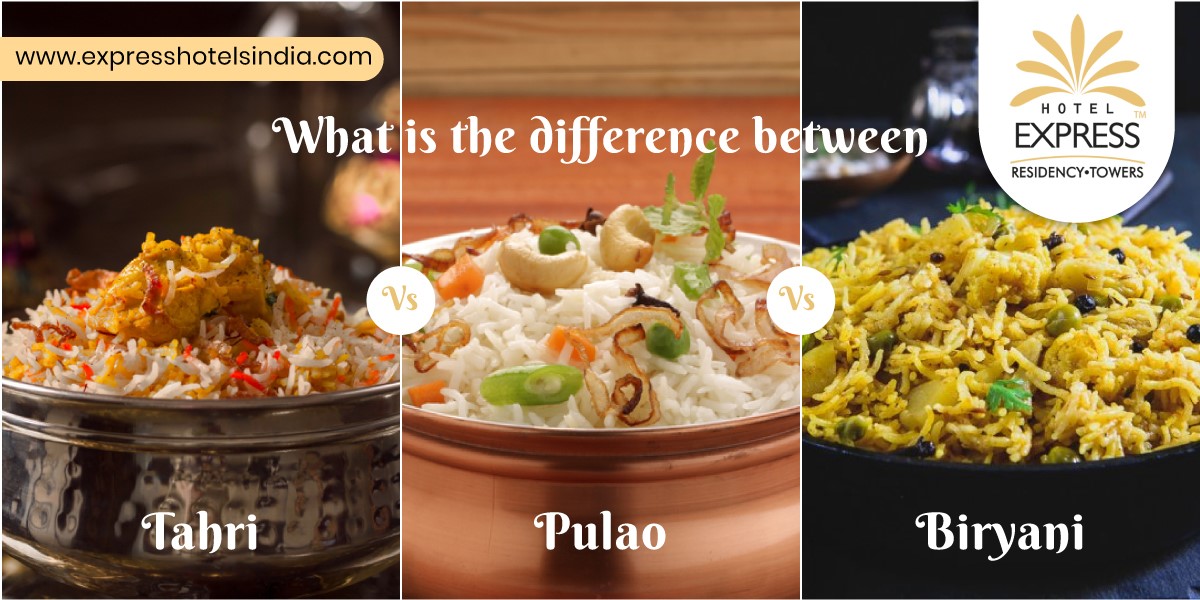Origins of Biryani and Pulao:
One popular misconception is that pulao or pulav is an Indian dish. There could have been a comparable dish in India at the time, but we don’t know if it was called pulao or something similar.
However, some accounts indicate that pulao began in central Asia, most likely with the Abbasid Caliphate, which is modern-day Baghdad. It spread from here to India, Europe, Africa, Latin America, the Middle East, and elsewhere. The Biryani originated in India and spread throughout the world in its original form and modifications. And each region created a unique variation of the biryani based on the available ingredients and rice quality.
Express Hotels India is one of the best Indian traditional food serving restaurants in Jamnagar, Gujarat.
● Certain Similarities:
- Pulao and biryani are both rice dishes.
- Biryani & Pulao – both the finest dishes are cooked on dum (smoke & heat).
- Originally, both pulao and biryani were made with meat.
- Both pulao and biryani now have vegetarian versions.
People and cultures have contributed diverse ingredients to both pulao and biryani over the years, resulting in a steady evolution for both. It can be perplexing at times because biryani and pulao appear to overlap.
Let’s start at the beginning and learn what pulao and biryani originally meant. Before we begin, I’d like to point you that pulao and biryani were both traditionally made with meat and never just vegetables.
If you are looking to take a weekend getaway to one of the best restaurants in Vadodara, Express Hotels India is the right place for you.
What is Pulao?
Pulao is a dish that combines rice and meat in a single pot. Meat is boiled or stewed (never fried or cooked directly in fat) with spices, sauces, fat, and other ingredients, and then soaked rice is added. The meat tenderises and the rice absorbs the flavours of the dish as it cooks covered on low heat.
The most popular and best example of a traditional Pulao is Yakhni pulao or Akhni pulao. However, when pulao arrived in India as a result of Islamic invasions, the recipe for this dish changed.
What is Biryani?
Biryani is derived from the word “Biriyan Kardaan,” which means “to fry/cook,” or “khane ko bhun-na” in Hindi. Before adding rice, meats were cooked/stir-fried in fat with spices and other ingredients. Because enormous amounts of rice and meat had to be cooked, the stacking of meat and rice began in Biryani, which has become one of the distinctive aspects of a biryani.
Express Hotels India is one of the most distinguished and good restaurants in Vadodara, serving authentic Indian food.
As the cuisine evolved and prospered, so did the varieties of biryani and pulao. Some people added curd, some people added potatoes, some people used basmati rice, some people started using parboiled rice, and so on. Also made were kachi dum biryani and pakke gosht ki biryani.
Because Delhi was the seat of power for any invader, it is fair to assume that the area in and around Delhi is where biryani reached its pinnacle, and from here it grew and spread to different states, each with its own twists and turns.
So it is true to claim that as time has passed, we have invented veg pulao and veg biryani, both of which were unheard of in the past.
To summarise, the basic difference between a biryani and a pulao is that for biryani, you must “Biriyan” aka fry the meat (though a variation, Hyderabadi Kacche Gosht ki Biryani Exists) and add whole and powdered spices and condiments to the meat & rice while cooking, whereas, for pulao, the meat is stewed rather than fried (though some versions now fry the meat and then make a (though nowadays heavily spiced pulaos are also popular)
Express Hotels India is one of the best Italian restaurants in Vadodara, Gujarat.
What is a Tahri / Tahiri / Tehari?
Tahiri or tehri is a traditional vegetarian rice dish from the Indian state of Uttar Pradesh. It is a vegetarian rice dish with spices similar to those used in biryani, and it is frequently confused with pulao. The vegetables are cooked in half with whole and powdered spices, curd, and fried onions. Soaked uncooked rice is added and combined with water before being cooked over dum. This results in a hotter veg version of Awadhi biryani. However, if you look attentively, you will notice that a tehri has employed both ways for creating biryani and pulao. The “bhun-na” / sautéing the vegetables with a variety of fragrant spices is apparently inspired by biryani cuisine, whereas the cooking of rice and vegetables together without the layers of spices is presumably inspired by pulao. Some of the most popular tahris include Aloo ki Tahri, Veg Tahri, and so on, while non-vegetarian tahris, particularly those made with mutton – Gosht ki Tahri and chicken – Murg Tahri – have gained popularity over time.
● Origins of Tahri:
Tahri may have originated with the vegetarian Hindu population, who were likely influenced by the manner of creating biryani in which meat was replaced with seasonal vegetables. Tahri or Tahiri was a famous dish in the Awadh region, but it is now enjoyed and cooked by people all over the world. Though pulaos were introduced to India through Islamic invasions, and biryani was developed as a result, we often forget that India was always a place of plenty, with rice as a staple. It is very likely that before the pulao arrived on the Indian subcontinent, there were rice-based foods prepared throughout India that were comparable to pulao. Perhaps a tehri is one of the original Indian subcontinental preparations.









